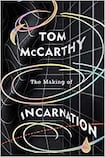
Tom McCarthy’s fifth and arguably most ambitious novel brings to mind Theodor Adorno’s definition of art as “magic delivered from the lie of being truth”. The Making of Incarnation is about bodies in space – outer space in the case of the sci-fi blockbuster (Incarnation) that serves as both armature and mise en abyme. Here, the lie of being truth (which another character describes as “[n]aturalist bullshit”) must be perpetuated at all costs.
Ben Briar is flown in from the United States as part of a shadowy project called Degree Zero (a nod to Roland Barthes and his reality effect) to ensure that the film’s script, however fanciful, complies with the basic laws of physics. Herzberg, the art director, expends a great deal of energy convincing this “Realism Tsar” that the inclusion of mundane objects in the unlikeliest of set-ups can effectively “counteract the defamiliarisation”. Much is subsequently made of the CGI rendering of a fork (“your basic IKEA Livnära”) that recurs – comically as well as cosmically – throughout the climactic disintegration of the spacecraft.
Given that Briar works for a consultancy called Two Cultures (vide CP Snow), it is hardly surprising that he should view physics as a creative endeavour – “a plunge into the farthest-flung reaches of the imagination”. The unfolding of the plot, as the shoot progresses, is interspersed with complex descriptions of the wind tunnels and motion-capture techniques deployed behind the scenes. These are so meticulously detailed that they take on a hypnotic, almost hallucinatory quality.
Kinesis moves in mysterious ways: at every corner, the scientific turns out to be underpinned by the poetic – or even the messianic. Pantaray Motion Systems is not only the slightly sinister corporate behemoth providing the cutting-edge technology without which there would be no movie; it also has “a heroic status tinged with traces of the mystical”.
Anthony Garnett, its founder, recalls once considering Norbert Wiener (the originator of cybernetics) as “prophet, messiah and apostle”. There was something in his vision that he thought “he’d left behind with Aeschylus, Catullus, Sappho: a condition best denoted by the old, unscientific label poetry”.
Garnett’s colleague Pilkington – referred to behind his back as the “Ancient Mariner” – senses that all machines are “stand-ins for some ultimate machine we’ll never build but nonetheless can’t stop ourselves from trying to”. Tasked with orchestrating an experimental plane crash, he goes looking for the “ur-disaster” – the “totality that hovers above every partial iteration”.
Monica Dean, who is conducting research into Lillian Gilbreth, discovers that the pioneer of factory-floor ergonomics had come to entertain “the possibility of some ‘higher’ or ‘absolute’ movement ... derived from no source other than itself”. The novel is teeming with such intimations of preordained patterns or underlying algorithms.
In this quest for perfection, the human body is ultimately an obstacle. We are reminded that the French scientist Marey sought to infuse his compatriots with the “energy and dynamism of the locomotive” and that Taylorism was seen by some in the Soviet Union as an opportunity to liberate the worker from “the shackles of his very body”. This rejection of incarnation is (paradoxically) embodied by the film’s high romantic denouement: the two lovers, whose union is impossible, bow out in a blaze of glory, expecting to coincide with themselves – and everything – at the instant of their deaths.
The novel, however, does not end with the blinding light of revelation, but a “blackness neither rays nor traces penetrate”. Besides, there is an error in the code behind the film’s final frame – an invisible blemish only the technician is aware of. It recalls Pilkington’s secret that he alone was responsible for the failure of Project Albatross, a minute miscalculation having led the plane to vanish instead of crashing. He imagines the lost aircraft occupying “an aporia, blind alley, cubby-hole or nook”.
This instant of its disappearance, “cut out from the flow of time” – for ever suspended, deferred – is akin to the sense of dislocation that several characters experience: the feeling of being in two locations at once “without really being in either”; of experiencing the present and the past simultaneously while being at one remove from both.
Is not this liminality the very space of fiction, squatted by the two addicts, who reappear right at the end, lost in their pipe dreams and inevitably conjuring up Beckett’s Vladimir and Estragon?
The answer, no doubt, is to be found in Lillian Gilbreth’s Box 808 – the one that allegedly “changes everything”, that may “chisel a Northwest Passage through a stretch of the hitherto theoretical-physically impossible”. The one that is missing, of course, and that everyone – from the protagonist, Pantaray’s Dr Mark Phocan, to the secret services – is looking for.
The truth is out there: Tom McCarthy has worked his magic once again.











